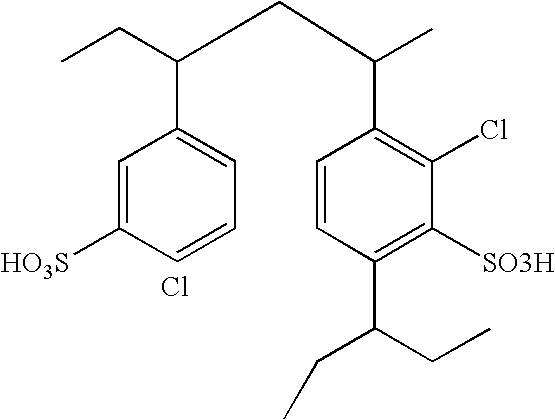Methods, systems and catalysts for the hydration of olefins
a technology of olefins and catalysts, applied in the field of methods, systems and catalysts for the hydration of olefins, can solve the problems of corroding a reactor, long reaction time, loss of so.sub.3h groups,
- Summary
- Abstract
- Description
- Claims
- Application Information
AI Technical Summary
Benefits of technology
Problems solved by technology
Method used
Image
Examples
example 2
[0030] Chlorination of Polymer:
[0031] The following procedure is representative for all examples and chlorinations. However, it is appreciated that other chlorination procedures can be used to obtain the properties of the catalyst described herein: In a two liter glass reactor connected to a water circulation bath is placed 490 ml of wet Amberlyst 36. To this is added 1180 g of water, and after stirring the water circulation bath is set to 35 C. The system is purged out for ten minutes with house nitrogen and then chlorine is introduced into the reactor at 15 psig. The chlorine feed rate is a function of reaction rate and can be monitored by measuring weight loss of lecture bottle. The percent HCl in the liquid is a measure of how much chlorine is on the resin since each Cl atom on the resin produces one HCl which dissolves in the water. This serves as a tool to gauge how much chlorine is on the resin. Aliquots of solution can be removed and titrated with base to measure percentage ...
example 3
[0032] The following experiment illustrates that base treatment removes leachable chlorine: 75 grams of wet resin F was mixed with 220 ml of 50% NaOH and heated for 4 hours at 130 C. The resin was filtered and the filtrate plus washes were weighed. A 10 g sample of the filtrate was treated with nitric acid to a pH of 2, then titrated with silver nitrate. Based on this result the amount of chlorine in 10 gm of filtrate was normalized to the overall weight of filtrate plus washes. The amount of leachable chlorine in 75 g of wet resin was determined as 1.46 g. The same experiment when repeated at room temperature for ten minutes gave only 0.47 g of chlorine showing that the heat treatment with base removes additional chlorine from the polymer.
example 4
[0033] The following base treatment procedure was used to make resins A, B, D, E. Approximately 275 grams of chlorinated resin (washed with 1500 ml of deionized water) was placed in a 3 neck round-bottomed flask equipped with a mechanical stirrer, water condensor and a Thermowatch. To this was added 1192 ml of a 2N NaOH solution. The mixture was stirred and heated to reflux (103 degrees C.) for a total of 22 hrs. The solution was separated from the resin and combined with a 100 ml washing of the resin. The solution was acidified with HNO.sub.3 and then titrated with silver nitrate for chloride determination. The resin was washed 3 times with 500 ml of deionized water then transferred to a column and washed with 3 liters of water (3 hrs) and 3 liters of 4% hydrochloric acid (3 hrs) and then three liters of water (3 hrs).
[0034] For resin A--the following was found before base treatment: 29.7% Cl, 8.2% S. After base treatment, the following results were obtained: 26.78% Cl, 8.62% S. Th...
PUM
| Property | Measurement | Unit |
|---|---|---|
| time | aaaaa | aaaaa |
| pH | aaaaa | aaaaa |
| weight | aaaaa | aaaaa |
Abstract
Description
Claims
Application Information
 Login to View More
Login to View More - R&D
- Intellectual Property
- Life Sciences
- Materials
- Tech Scout
- Unparalleled Data Quality
- Higher Quality Content
- 60% Fewer Hallucinations
Browse by: Latest US Patents, China's latest patents, Technical Efficacy Thesaurus, Application Domain, Technology Topic, Popular Technical Reports.
© 2025 PatSnap. All rights reserved.Legal|Privacy policy|Modern Slavery Act Transparency Statement|Sitemap|About US| Contact US: help@patsnap.com

